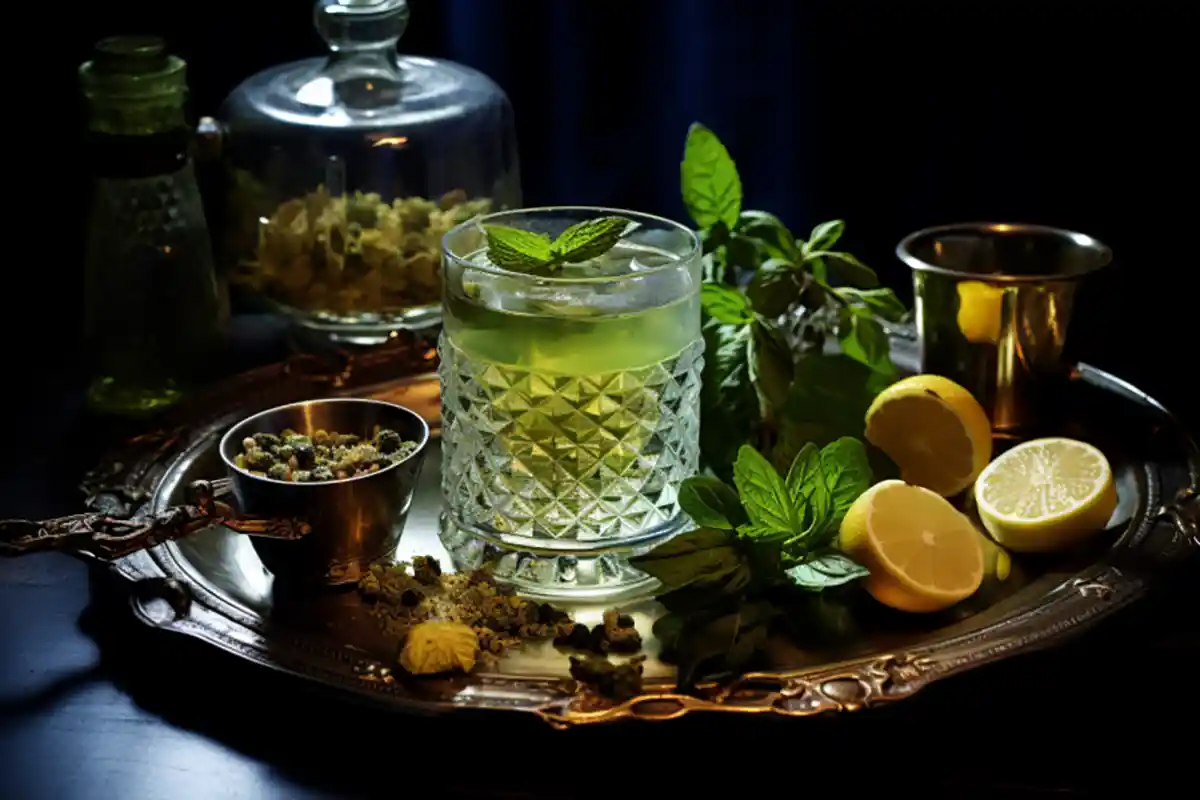In the realm of gastronomy, there exists a captivating dance between flavors and spirits. A symphony of tastes and aromas unfolds, transcending the ordinary and unveiling a world of sensory delights. Amidst this harmonious interplay, one particular spirit stands tall, captivating the palates of connoisseurs and enchanting the hearts of adventurers. It is none other than absinthe, the famed “Green Fairy.” With its distinct emerald hue and a reputation steeped in mystique, absinthe has long been associated with artistic brilliance and bohemian revelry. In this article, we delve into the realm of perfect pairings, exploring the enchanting union of absinthe and cuisine.
1. Introduction: The Elixir of Legends
Absinthe, with its bewitching emerald hue and rich cultural history, has captured the imagination of generations. This intriguing spirit traces its origins back to the late 18th century and has become synonymous with creativity and indulgence. The allure of absinthe lies not only in its vibrant color but also in its complex and herbal flavor profile. It is this very uniqueness that makes it a compelling companion to various culinary experiences.
2. The Rise and Fall: A Brief History of Absinthe
Absinthe’s story is one shrouded in controversy and legend. Developed in the late 18th century by a French doctor named Pierre Ordinaire, absinthe quickly gained popularity as a medicinal elixir. However, it was during the 19th century that absinthe reached its zenith, becoming a beloved spirit across Europe. Its association with artists, writers, and bohemian culture solidified its place in history. Unfortunately, due to misconceptions and the temperance movement, absinthe was banned in many countries during the early 20th century. It was only in recent years that the ban was lifted, leading to a revival of this once-vilified spirit.
3. Unlocking the Essence: Understanding Absinthe
Absinthe is a distilled spirit infused with a combination of botanicals, including the grand wormwood herb (Artemisia absinthium), anise, and fennel. These ingredients contribute to its characteristic herbal, anise-forward flavor. The spirit is also known for its high alcohol content, typically ranging from 45% to 74% ABV (alcohol by volume). It is this potent elixir that imparts its unique qualities to culinary pairings.
4. A Symphony of Flavors: Exploring Absinthe Varieties
Absinthe comes in various styles, each with its own flavor nuances. Traditional absinthe, often referred to as “verte” or “green absinthe,” is characterized by its vibrant color and complex herbal profile. On the other hand, “blanche” or “white absinthe” is distilled without the addition of coloring herbs, resulting in a clear spirit with a distinct anise flavor. Additionally, there are contemporary variations that experiment with different botanical combinations, offering a diverse range of flavors to explore.
5. Unveiling the Pairings: Absinthe and Gastronomy
5.1 Appetizers and Absinthe: Opening the Palate
To commence a remarkable culinary journey with absinthe, appetizers serve as the perfect gateway. Delicate seafood, such as oysters or smoked salmon, complements the herbal notes of absinthe, creating a harmonious interplay of flavors. A platter of artisanal cheeses, accompanied by crusty bread and honey, offers a delightful contrast to the spirit’s intensity.
5.2 Main Courses and Absinthe: A Fusion of Tastes
As the main course takes center stage, the possibilities for pairing absinthe abound. Rich and savory dishes like roasted duck or grilled lamb find a worthy companion in the spirit’s complex botanical profile. For vegetarians, earthy dishes featuring mushrooms or roasted root vegetables harmonize beautifully with absinthe’s herbal essence.
5.3 Desserts and Absinthe: Sweet Intoxication
Indulgence reaches its zenith when absinthe and desserts come together in a dance of decadence. A classic pairing involves a luscious chocolate dessert infused with absinthe, tantalizing the taste buds with a symphony of bittersweet flavors. Alternatively, a citrus-infused dessert, such as lemon tart or orange crème brûlée, balances the spirit’s herbaceous notes with refreshing zest.
5.4 Cheese and Absinthe: A Match Made in Heaven
Cheese lovers rejoice, for the marriage of absinthe and cheese is one of sublime delight. Strong and pungent cheeses, such as Roquefort or Gorgonzola, find harmony in the spirit’s robust character. The anise undertones of absinthe elevate the flavors of the cheese, resulting in an unforgettable gustatory experience.
6. The Art of Absinthe Cocktails: Mixology Masterpieces
Beyond the realm of gastronomy, absinthe takes center stage in mixology. Crafted with care and creativity, absinthe cocktails offer a myriad of flavors to explore. The classic Sazerac, with its combination of rye whiskey, absinthe, and bitters, showcases the spirit’s ability to enhance and elevate a cocktail. Other iconic absinthe-based concoctions, such as the Corpse Reviver No. 2 or the Death in the Afternoon, carry the spirit’s legacy forward, delighting cocktail enthusiasts with their complexity and allure.
7. The Ritual of Preparation: Louche and L’heure Verte
Part of absinthe’s allure lies in its unique ritual of preparation. As the spirit is traditionally served, it undergoes a mesmerizing transformation known as the louche. Ice-cold water is slowly dripped over a sugar cube placed on an absinthe spoon, causing the spirit to cloud and release its aromatic bouquet. This captivating display, known as l’heure verte (the green hour), adds to the enchantment surrounding absinthe.
8. Absinthe’s Revival: Modern-day Appreciation
After years of prohibition, absinthe has experienced a revival in recent times. With a renewed interest in traditional spirits and craft cocktails, absinthe has found its place once again on the shelves of discerning establishments. Artisans and distillers pay homage to the spirit’s rich history, crafting exquisite absinthes that capture the essence of a bygone era. The revival of absinthe ensures that its captivating spirit will continue to enthrall and inspire for generations to come.
9. Conclusion
In the realm of gastronomy, the enchanting dance between absinthe and cuisine creates a symphony of flavors and sensations. From delicate appetizers to indulgent desserts, the spirit’s herbal essence weaves its magic, enhancing the culinary experience. Whether sipped neat, enjoyed in a cocktail, or savored alongside a cheese platter, absinthe offers a glimpse into a world of poetic indulgence.
Frequently Asked Questions (FAQs)
- Is absinthe legal now?
- Yes, absinthe is legal in many countries, including the United States and several European nations. However, regulations may vary, so it’s essential to check the laws in your specific location.
- Does absinthe make you hallucinate?
- The notion of absinthe causing hallucinations has been largely debunked. The myths surrounding its hallucinogenic effects were a result of misconceptions and exaggerations in the past.
- What is the traditional way to serve absinthe?
- Traditionally, absinthe is served by placing a sugar cube on an absinthe spoon positioned over a glass. Ice-cold water is then slowly dripped over the sugar cube, causing the absinthe to louche and release its aromas.
- Can absinthe be mixed with other spirits?
- Absinthe can indeed be mixed with other spirits to create unique and flavorful cocktails. Classic absinthe cocktails, such as the Sazerac and Corpse Reviver No. 2, showcase the versatility of this spirit.
- Where can I buy absinthe?
- Absinthe can be found in well-stocked liquor stores, specialty spirits shops, and online retailers. Ensure that you choose a reputable brand and check the alcohol regulations in your area before making a purchase.









